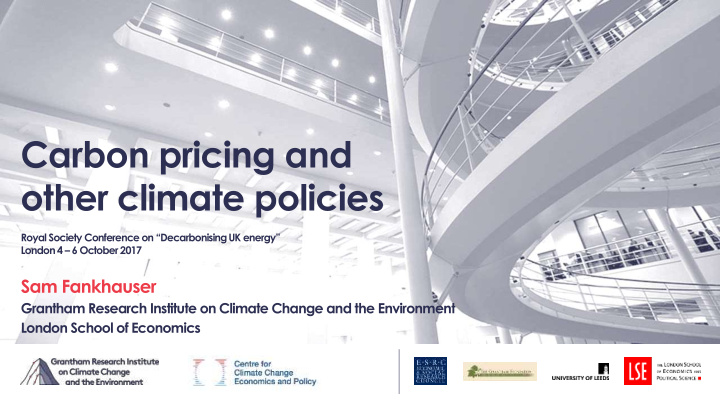



Carbon pricing and other climate policies Royal Society Conference on “Decarbonising UK energy” London 4 – 6 October 2017 Sam Fankhauser Grantham Research Institute on Climate Change and the Environment London School of Economics
Overview • UK and global context • Implications for carbon policy ― A suite of policy interventions ― A new approach to carbon pricing 2
The global emergence of carbon pricing Either through carbon taxes or emissions trading schemes Source: World Bank, State and Trends of Carbon Pricing 2016
The UK context: A growing policy gap 2018-32 carbon targets (budgets 3-5) require steep emission cuts Power sector decarbonisation is on track, but elsewhere progress has stalled Current policies will only deliver half the required emission cuts Need to replace EU-based regulation after Brexit (e.g. EU ETS) Source: Progress Report 2017, Committee on Climate Change 4
Need for stronger policies across the board Suite of interventions to address different market failures UK examples Address the climate Carbon Pricing EU ETS, CCL, carbon price change externality floor Clean innovation CfDs, RHI, RO Remove associated ECO, DEC, efficiency Energy efficiency standards barriers Green finance GIB Competitiveness Compensation, free Mitigate unintended allowances consequences Winter fuel payment, warm Fuel Poverty home discount 5
Need for stronger policies across the board Suite of interventions to address different market failures Address the climate Carbon Pricing change externality Clean innovation Remove associated Energy efficiency barriers Green finance Competitiveness Mitigate unintended consequences Fuel Poverty 6
Carbon pricing in the UK is complex and uneven More focus on carbon pricing as other market imperfections are overcome Implicit carbon price on electricity Implicit carbon price on natural gas Source : Advani et al, Institute for Fiscal Studies and Centre for Climate Change Economics and Policy, 2013. 7
A approach: the soft Brexit option Carbon pricing via emissions trading (and EU ETS membership) Carbon dating: Which emissions trading scheme A UK-only emissions trading scheme has should the UK link up with? disadvantages Criteria for success EU ETS California China Small size offers fewer trading opportunities • ☺☺☺ ☺☺ ☺☺☺ Bigger markets offer more A potentially less liquid market • benefit ☺ ( ☺ ?) ☺☺ ☺☺☺ Less correlated markets EU ETS is the best system for a UK offer more benefits scheme to link up with ☺☺☺ Creating new links is a ─ ─ costly process Remaining in the EU ETS is therefore the best emissions trading option Scores d erived from: Taschini and Doda, Journal of the Association of Environmental and Resource Economists, 2017. 8
A new approach: the hard Brexit option Replace EU ETS with an economy-wide carbon tax Many experts prefer carbon taxes over emissions trading ─ Relatively easy to administer using existing fiscal processes ─ More suitable for smaller emitters without trading skill ─ Different characteristics during business cycle fluctuations Carbon tax proposal could build on (and “clean up”) existing pricing schemes E.g., turn Climate Change Levy into a true carbon tax • E.g., extend the carbon price floor to all sectors • 9
How to make carbon taxes acceptable publicly Passing a carbon tax may require deviations from the economic “first best” Phased carbon taxes are more acceptable ─ People dislike high taxes, even Pigouvian taxes that make polluters pay ─ But they change their mind when the experience the tax and see benefits ─ Risk: tax may get stuck at the wrong level Specify (and communicate) the use of tax revenues ─ People don’t think carbon taxes work; they see them as a way to raise revenue ─ Earmarking revenues for further emission reductions is most popular use of proceeds, followed by redistribution to achieve a fiscally progressive outcome ─ Least popular is commitment to cut other, distortionary taxes (“double dividend” argument) ─ Risk: Earmarking is not good fiscal practice 10
Need for stronger policies across the board Suite of interventions to address different market failures Address the climate Carbon Pricing change externality Clean innovation Remove associated Energy efficiency barriers Green finance Competitiveness Mitigate unintended consequences Fuel Poverty 11
Societal benefits of low-carbon innovation justify intervention Patent citations relative to average (ave = 0) Low-carbon innovation provides higher spillover externalities than high-carbon innovation in the same sectors Low-carbon innovation has spillover potentials that are similar to other high yield sectors Source: Dechezleprêtre, Martin, & Mohnen , Grantham Research Institute, 2016 12
Uptake of energy efficiency measures changes with policy Although recent policy changes have not been beneficial
Higher energy prices affect fuel poverty Energy efficiency has so far offset the price effect Source: Committee on Climate Change, Energy Prices and Bills, March, 2017
UK decarbonisation The next phase Contact: s.fankhauser@lse.ac.uk
The global context: Action by (almost) all Over 1,200 climate laws worldwide (up from ca 60 laws in 1997) Source: Climate Change Laws of the World, Grantham Research Institute, LSE 16
Policy intervention along the entire innovation chain • Upstream research and development − R&D grants, patent protection, venture capital • Downstream demonstration and deployment − Tax breaks, supplier obligations, feed-in tariffs − UK: Contract for Differences for clean technologies • Balance is tilted toward deployment at the expense of R&D − Though substantial additional support for R&D was promised at the Paris COP (Mission Innovation)
Financing barriers may affect speed of decarbonisation • Redirection of existing capital flows to low-carbon is as important as additional capital (perhaps more so) • Several barriers hold back redirection of capital – Generic barriers that affect low-carbon investment (e.g. SME finance) – Barriers specific to low-carbon investment (eg. perceived risks; riskier investment profile) • Policy interventions may facilitate capital flows – UK: Green Investment Bank to share risks
Unilateral action may affect competitiveness UK: Concern for only a few industries, but how to support them? Source: Sato, Neuhoff et al., Environ Resource Econ (2015)
Recommend
More recommend